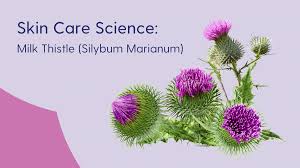
The Science of Milk Thistle Extract in Skin Care
Milk thistle (Silybum marianum) is a rising star in skin care, and not just because it’s pretty. This botanical beauty has a variety of skin benefits to offer, including anti-aging, anti-inflammatory, and antioxidant properties. While this ingredient is generally well-tolerated by most skin types, milk thistle is most often included in formulations with other ingredients, so make sure any milk thistle product you are using is right for your Baumann Skin Type.
Milk thistle is a great skin care ingredient for anti-aging and soothing inflammation.
It can offer added protection against sun damage and oxidative stress.
Don’t use it if you are allergic to other plants in the same family, like ragweed, daisies, or marigolds.
What Is Silybum Marianum?
Milk thistle, also known as Silybum marianum, is a flowering herb related to the daisy and ragweed family. It is native to Mediterranean countries but is now found throughout the world. Historically, milk thistle has been used for its medicinal properties, primarily for liver health. The seeds and leaves contain a group of compounds called silymarin, which have strong antioxidant and anti-inflammatory properties, making them excellent additions to many skin care products.
What Is Silymarin?
Silymarin is a group of flavonoids extracted from the seeds of the milk thistle plant. The main active compounds in silymarin are silybin, silydianin, and silychristin. Silybin, also known as silibinin, is the most potent and well-researched of these compounds. Together, these flavonoids provide powerful antioxidant, anti-inflammatory, and detoxifying effects.
How Is Silybum marianum Used in Skin Care?
Milk thistle is primarily used in skin care for its silymarin content, which is known to provide several benefits. Here are the common ways milk thistle is incorporated into skin care:
Antioxidant protection. Silymarin is a powerful antioxidant that helps protect the skin from free radicals. Free radicals can cause premature aging by damaging skin cells and breaking down collagen if left unneutralized.
Anti-inflammatory properties. Silymarin’s anti-inflammatory effects can help reduce redness and swelling, making it beneficial for conditions like acne and rosacea.
UV protection. Some studies suggest that milk thistle can help to protect the skin from UV damage, which can lead to sunburn and increase the risk of skin cancer. However, this ingredient should not be used as your sole method of sun protection – though it may offer extra protection against sun damage.
Benefits of Milk Thistle in Skin Care
Silybum marianum can provide your skin with a number of benefits. Most notably:
Anti-aging. The antioxidant properties of milk thistle can help to reduce the appearance of fine lines and wrinkles by protecting the skin from oxidative stress.
Acne treatment. Due to its anti-inflammatory properties, milk thistle can help reduce the redness and swelling associated with acne. It also helps to regulate oil production, which can help to prevent future breakouts.
Hyperpigmentation reduction. Milk thistle can help to lighten dark spots and improve hyperpigmentation. Its compounds inhibit the production of excess melanin, which causes dark spots.
Skin soothing. For those with sensitive skin, milk thistle’s soothing anti-inflammatory properties can help to calm irritation and redness.
What is Milk Thistle Made of?
Milk thistle, scientifically known as Silybum marianum, has more going for it than a “silly” name. It is a flowering plant that’s made of several interesting compounds with skin care uses. The main active ingredient in milk thistle is silymarin, a complex of flavonolignans that includes silibinin, silychristin, and silydianin. Silymarin is prized in many products for its strong antioxidant properties, which help protect skin cells from oxidative stress and damage caused by free radicals.
Silibinin, the most potent component of silymarin, is especially notable for its ability to promote collagen synthesis. It also has anti-inflammatory properties, making it effective in soothing irritated skin and reducing redness. This versatile ingredient also contains fatty acids and vitamin E, both of which contribute to its versatile effects. These components make milk thistle a valuable ingredient in skincare products able to protect, repair, and calm the skin.
Which Products Contain Silybum marianum?
Many skin care products include Silybum marianum for its anti-aging and anti-inflammatory properties. Here are a few of my favorites:
Milk Thistle Side Effects
Milk thistle is generally safe with minimal side effects when applied topically. Safety organizations such as the Environmental Working Group (EWG) have graded it as safe for use in skin care. However, if you are allergic to plants in the same family as milk thistle, such as ragweed, daisies, marigolds, or chrysanthemums, avoid using milk thistle in skin care.
The only reason not to use this ingredient would be if the product formulation wrong for your skin type.
Bottom Line: Is Silybum marianum Right For Your Skin?
Milk thistle can be a valuable addition to your skin care routine, particularly if you’re looking for natural, plant-based ingredients with proven benefits. Its antioxidant and anti-inflammatory properties can help to protect and soothe the skin, reduce signs of aging, and combat acne and hyperpigmentation. However, it is essential to choose products that are well-formulated and to be mindful of potential allergies. For personalized advice, learn your Baumann Skin Type by taking the quiz at Skintypesolutions.com to see if milk thistle is a good fit for your specific skin type.


